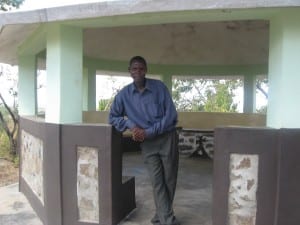Before delving into this third posting from Malawi, I think it will help the reader get a better sense of what they are reading if they get to know a little bit more about the man who has so kindly invited us all into his teaching community. What follows is a short autobiography written by Mr. Lemani which will then lead into this week’s look at classroom teaching approaches from both the eyes of Sophie and then Mr. Lemani. The comparisons between practices here in Quebec and those in Malawi are quite interesting and will leave you with much to think about. Happy reading!
 Introducing Mr. Lemani
Introducing Mr. Lemani
by Henry Lemani
My name is Henry Lemani. I was born on December 28th, 1970. From 1987 to 1991, I did my secondary education at Dowa Secondary School where I obtained my Junior Certificate of Education (JCE) and Malawi School Certificate of Education (MSCE), which is equivalent to Ordinary Level. From 1992 to 1994, I was trained as a primary school teacher at Kasungu Teachers Training College. In 1994, I married Catherine Lodzeni. Our family is blessed with four children. One of my daughters is adopted. Her name is Mphatso (which means gift in English). The other three are biological: a boy by the name of Pemphero and two girls named Florida and Naomi. From 1994 to 2003, I taught in various primary schools. In 2003, I obtained a certificate for secondary school and then from 2004 to 2007, I obtained a diploma in secondary education. From there, I became a secondary school teacher. In 2010, I was admitted into Mzuzu University for a Bachelor of Education Degree, which will be completed in 2013. My hobbies are listening to current affairs and watching soccer. My future aspirations consist of obtaining my Masters degree in either of the following: strategic planning and management, educational leadership, sociology or testing and measurement.
Malawian Teaching Methods
through the eyes of Sophie Bass
During the summer of 2011, I had the opportunity to visit, observe, and dialogue with teachers from three different schools, all of which are located in a village called Chilanga: Chilanga Sighted Primary School, Chilanga School for the Blind, and Chilanga Community Day Secondary School. This year, Mr. Lemani decided that it would be a good idea for me to visit another primary school located outside of Chilanga, Mponda Primary School. Mr. Lemani felt that I would be better suited to discuss the teaching methods that Malawian teachers use if the sample of teachers that I observed was bigger. I willfully agreed and, on June 6th, we walked to Mponda Primary School where I observed three different teachers teach three different lessons.
The teaching methods that I observed last year and the ones I observed at Mponda Primary School this year are not so different from the ones that teachers use in Quebec. For instance, more often than not, I have witnessed teachers in Malawi make use of real-life examples, concrete objects, and illustrations – particularly when teaching English, Mathematics, and Science – in an attempt to help students make connections between the knowledge they learn in school and the world outside the classroom. For example, at Mponda Primary School, I watched a standard 6 teacher teach a mathematics lesson on volume. He used a box to help students understand the meaning of volume. Moreover, I have witnessed many teachers in Malawi use drill and practice exercises in order to help students master certain concepts. Although we are trying to stray away from such practices in Quebec, many teachers still use these types of exercises in their classrooms. Undoubtedly, it can be argued that drill and practice exercises still have a place in Quebec classrooms and, as such, can serve to benefit the students (but what do I know, I am only a pre-service teacher, not an expert, and this is simply me reflecting on my experiences).
Teachers in Malawi also vary their activities often. According to Mr. Lemani, in standard 1 and 2, each lesson lasts a maximum of 30 minutes. From standards 3 to 8, lessons last approximately 35 minutes each. At Bishop’s University, I have learned how important it is to vary my instruction frequently, particularly with the younger students, because they have relatively short attention spans (which is completely normal since they are children – in fact, many adults have short attention spans too, especially when unengaged!). In addition, I have often witnessed teachers in Malawi begin their lessons with a review of what was previously taught, followed by the use of modelling to teach new concepts (common practices in Quebec also).
Overall, from my perspective, I would have to say that the lessons I observed in Malawi were quite teacher-centered, even though many teachers talk about the importance of teaching in a student-centered way like in Quebec. I feel that there is a discrepancy between what teachers say education should be about and what is actually done in both the Malawi and Quebec classroom. If my understanding of the term ‘teacher-centered’ is accurate, the use of drill and practice exercises, frequent modelling, and lecturing are all teacher-centered approaches. Since the Quebec reform, pre-service teachers are instructed to create classrooms that are constructivist and student-centered in nature. Nonetheless, many teachers in Quebec still make extensive use of behaviourist and teacher-centered techniques. Perhaps this is because these strategies still have a certain place in today’s classroom and because it is difficult, despite all our attempts, to teach in a way that is different from the way we were taught as children. Since the reform in Malawi, pre-service teachers are also told to create classrooms that are student-centered. Nevertheless, many teachers resort to teacher-centered practices because a) they have a very strict and standardized curriculum that they must adhere to, b) perhaps the large classroom sizes, lack of resources, and lack of physical space inhibit teachers from teaching in a student-centered way, and c) they have probably never experienced what it feels like to be in a purely student-centered and constructivist classroom, much like pre-service teachers in Quebec like myself.
Mr. Lemani has written a response to my blog report below because it is essential for you, the readers, to obtain the perspectives of a teacher who actually lives in Malawi, as opposed to only hearing my opinions as an outsider. The way I view the education system in Malawi is different from Mr. Lemani because I do not live there and do not have the cultural frame and knowledge that he has. It would not be fair to the people of Malawi if you only received information through my Canadian eyes. Until next time, I wish you all the best.
Henry Lemani Responds
by H.Lemani
Despite the lessons that we observed at Mponda Primary School, I still believe that teachers must be as creative as much as possible. That is, teachers must use a variety of teaching methods and also use a variety of teaching and learning materials. In a nutshell, teachers are supposed to be facilitators in teaching and learning processes. Teacher-centered instruction is very much discouraged in Malawi. Students must be more involved. Sophie has only witnessed a small sample of lessons in Malawi. Therefore, although I agree that the lessons observed at Mponda Primary School were teacher-centered and were not very good, I think it is unfair to generalize that all teachers in Malawi teach in teacher-centered ways. I feel that there are some teachers who can teach the way it should be (pupil-centered), despite the limitations that we may face. Also, teachers do not always perform as well when they are being observed teaching lessons. Teachers feel nervous, pressured, and tense when this happens. Yet, they are excellent teachers when they teach in the absence of someone observing the lesson. Therefore, it is possible that these teachers did not teach as well as they usually do when both Sophie and I were present.





How fascinating to be able to see other teachers in action in Malawi! And what a privilege it is to have been granted access to watch someone else teach! What particularly strikes me is how important cultural values are in the choice of teaching approaches and methods. How important is community and togetherness in Malawi as compared to Quebec? What is the role of repetition and rhythm in the expression of culture? What do we really learn when we drill something aloud, in chorus with our classmates? As you pointed out, Sophie, as long as there is variety, drill exercises have their place, especially when you look at the larger cultural and pedagogical picture (“I before E, except after C! I before E, except after C!). And, finally, how do we account for teachers who want to show outsiders their best face – when they are unsure as to what the outsider “wants” to see?
Mr. Lemani, it was wonderful to read your thoughts. I, too, think that professionals who are being observed by strangers are in a difficult position. Often they do not know what is expected of them, and what other people view as good methods. It was not so long ago that a quiet classroom full of obedient children is what people wanted to see…
Lots to think about!